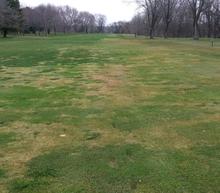About our project

Winter stresses have long been a challenge for professional turfgrass managers. The long-term goal of this coordinated agricultural project is to better understand turfgrass winter stresses and then identify solutions to this important specialty crop problem. Our approach will include research in plant breeding, genetics, and physiology; efforts to improve resistance to plant disease and thereby reduce pesticide applications; new technological innovations to predict winter stress damage more precisely; and modern approaches to engage and educate stakeholders.
The WinterTurf project is led by the University of Minnesota, in collaboration with University of Wisconsin-Madison, Michigan State University, University of Massachusetts, Iowa State University, Oregon State University, Rutgers University, Norwegian Institute of Bioeconomy Research, and hundreds of golf course superintendents across North America and Europe.
The project "WinterTurf: A holistic approach to understanding the mechanisms and mitigating the effects of winter stress on turfgrasses in northern climates" is supported by the USDA National Institute of Food and Agriculture under the Specialty Crop Research Initiative program.
Objectives
- Assess turf stands in cold climates to gain knowledge about the processes that lead to winterkill in a changing climate. We will use that information to define and prioritize main types of environments (called ‘envirotypes’) that lead to winter stress damage of turf, and create a winter stress injury prediction model that can help turfgrass managers make data-driven decisions before, during, and after winter stress.
- Design and execute experiments based on envirotypes identified in the first objective, while at the same time substantially improving our understanding of the physiological factors associated with turfgrass injury and tolerance due to stressors such as ice cover and freeze-thaw events.
- Monitor the environmental conditions that lead to disease development and learn more about the basic biology of snow mold pathogens and their level of fungicide resistance, which will allow us to develop more integrated snow mold management strategies, including new resistant cultivars.
- Breed improved cultivars of creeping bentgrass and perennial ryegrass that better tolerate winter stresses.
- Develop strategies for management of, and recovery from, winter stress damage and study the economics of turfgrass winter stresses.
- Create and implement an extensive outreach program aimed at multiple stakeholder audiences to disseminate recommendations resulting from our research, establish a portfolio of tools and resources, and facilitate local knowledge sharing among peers.